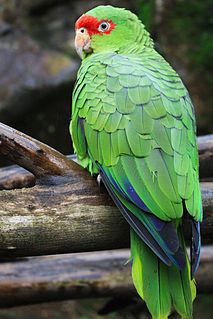 W
WThe red-spectacled amazon is a species of parrot in the family Psittacidae. It is found in Argentina, Brazil, and Paraguay.
 W
WThe Andean caenolestid, also known as the Andean shrew opossum or Condor caenolestid, is a shrew opossum known only from Cordillera del Cóndor (Ecuador), its type locality. It was first described by zoologists Bruce D. Patterson and Albuja V. Luis in 1996. It is the largest caenolestid. The IUCN classifies it as vulnerable. As of 2015, the population is estimated at less than 1,000.
 W
WThe Brazilian three-banded armadillo is an armadillo species endemic to eastern Brazil, where it is known as tatu-bola. It is one of only two species of armadillo that can roll into a ball. It has suffered a 30% decline in population in the last 10 years.
 W
WThe giant armadillo, colloquially tatou, ocarro, tatu-canastra or tatú carreta, is the largest living species of armadillo. It lives in South America, ranging throughout as far south as northern Argentina. This species is considered vulnerable to extinction.
 W
WThe hairy long-nosed armadillo, or woolly armadillo, is a species of armadillo in the family Dasypodidae. It is endemic to Peru. Its natural habitats are subtropical or tropical moist lowland forest and subtropical or tropical moist montane forest. The International Union for Conservation of Nature used to consider it a "vulnerable species" but has changed this assessment to "data deficient" because so little is known about the animal and the threats it faces.
 W
WThe tiny yellow bat is a species of vesper bat. It is found in Colombia and Venezuela.
 W
WThe big-headed Amazon River turtle, also known as the big-headed sideneck, is a species of turtle in the family Podocnemididae. The species is monotypic within the genus Peltocephalus.
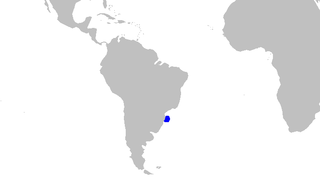 W
WThe southern sawtail catshark is a species of catshark, part of the family Scyliorhinidae, endemic to southern Brazil. It inhabits deepwater reefs on the upper continental slope at a depth of 236–600 m (774–1,969 ft). Reaching at least 43 cm (17 in) in length, this slim-bodied species closely resembles the Antilles catshark. It has a prominent crest of enlarged dermal denticles along the dorsal edge of the caudal fin, as well as a distinctive color pattern of dark oval blotches, outlined in white, along its back. The southern sawtail catshark is oviparous, with females producing reddish egg capsules. The International Union for Conservation of Nature (IUCN) has assessed it as Vulnerable; it is often taken as bycatch and may be threatened by intensifying squid fishing.
 W
WThe Colombian weasel, also known as Don Felipe's weasel, is a very rare species of weasel only known with certainty from the departments of Huila and Cauca in Colombia and nearby northern Ecuador. Both its scientific and alternative common name honours the mammalogist Philip "Don Felipe" Hershkovitz.
 W
WDinoponera lucida is a large queenless species of ant in the subfamily Ponerinae. The species, endemic to Brazil, is threatened by habitat destruction. Workers range from 27 to 30 mm in body length, which is slightly larger than the related species Dinoponera australis, but smaller than other large ants. Males are unknown.
 W
WPristimantis crucifer is a species of frog in the family Craugastoridae. It is endemic to Ecuador. Its natural habitats are tropical moist montane forests and rivers. It is threatened by habitat loss.
 W
WFernandez's sword-nosed bat is a species of bat in the family Phyllostomidae. It is the smallest species of the Lonchorhina genus. It is endemic to Venezuela. In 2013, Bat Conservation International listed this species as one of the 35 species of its worldwide priority list of conservation. It is threatened by habitat loss. It derives its scientific name from a Venezuelan zoologist, Dr. Alberto Fernandez Badillo, whose research focused on vampire bats, in particular.
 W
WThe giant anteater, also known as the ant bear, is an insectivorous mammal native to Central and South America. It is one of four living species of anteaters, the only extant member of the genus Myrmecophaga, and is classified with sloths in the order Pilosa. This species is mostly terrestrial, in contrast to other living anteaters and sloths, which are arboreal or semiarboreal. The giant anteater is the biggest of its family, 182 to 217 cm in length, with weights of 33 to 50 kg for males and 27 to 47 kg for females. It is recognizable by its elongated snout, bushy tail, long fore claws, and distinctively colored pelage.
 W
WThe sailfin grouper, also known as the bacalao grouper, colorado grouper or yellow grouper, is a species of marine ray-finned fish, a grouper from the subfamily Epinephelinae which is part of the family Serranidae, which also includes the anthias and sea basses. It is found off islands in the eastern Pacific.
 W
WThe smooth hammerhead is a species of hammerhead shark, and part of the family Sphyrnidae. This species is named "smooth hammerhead" because of the distinctive shape of the head, which is flattened and laterally extended into a hammer shape, without an indentation in the middle of the front margin. Unlike other hammerheads, this species prefers temperate waters and occurs worldwide at medium latitudes. In the summer, these sharks migrate towards the poles following cool water masses, sometimes forming schools numbering in the hundreds to thousands.
 W
WThe La Plata dolphin, franciscana or toninha is a species of dolphin found in coastal Atlantic waters of southeastern South America. It is a member of the river dolphin group and the only one that lives in the ocean and saltwater estuaries, rather than inhabiting exclusively freshwater systems. Commercialized areas that create agricultural runoffs and/or industrialized zones can affect the health of the La Plata dolphin, especially in regards to their contributions of waste and pollution, which can lead to habitat degradation and poisoned food among other concerns.
 W
WThe little red brocket or swamp brocket, also known as the Ecuador red brocket, is a small, little-studied deer native to the Andes of Colombia, Ecuador and northern Peru, where found in forest and páramo at altitudes between 1,400 and 3,600 metres. It is one of the smallest brocket deer. The coat is reddish, and the legs and crown are blackish. As recently as 1999, some authorities included both the pygmy brocket and Merida brocket as subspecies of the little red brocket.
 W
WThe buffy-tufted marmoset, also known as the buffy tufted-ear marmoset or white-eared marmoset, is a New World monkey that lives in the forests on the Atlantic coast of southeast Brazil. Of all the marmosets, it has the southernmost range.
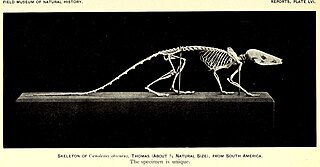 W
WThe northern caenolestid, also known as the blackish shrew opossum, is a shrew opossum found in Colombia and Ecuador. It is listed as Vulnerable by the IUCN.
 W
WOxyepoecus inquilinus is species of ant in the genus Oxyepoecus. It is endemic to Argentina. The species is listed together with two other Oxyepoecus species as "Vulnerable D2" by IUCN.
 W
WThe pacarana is a rare and slow-moving hystricognath rodent indigenous to South America. Native Tupi people call it the pacarana because it is superficially similar to the paca, a different rodent which is not in the same family. The pacarana has a chunky body and is large for a rodent, weighing up to 15 kg (33 lb) and measuring up to 79 cm (31 in) in length, not including the thick, furry tail.
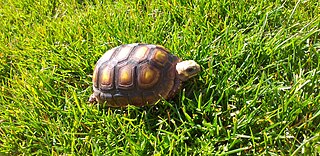 W
WThe red-footed tortoise is a species of tortoise from northern South America. These medium-sized tortoises generally average 30 cm (12 in) as adults, but can reach over 40 cm (16 in). They have dark-colored, loaf-shaped carapaces with a lighter patch in the middle of each scute, and dark limbs with brightly colored scales that range from pale yellow to dark red. Recognized differences are seen between red-footed tortoises from different regions. They are closely related to the yellow-footed tortoise from the Amazon Basin. They are popularly kept as pets, and over-collection has caused them to be vulnerable to extinction.
 W
WThe red-headed Amazon side-necked turtle, red-headed river turtle, or red-headed sideneck is a species of turtle in the family Podocnemididae. It is found in the Amazon basin in Brazil, Colombia, and Venezuela.
 W
WReig's opossum is a South American opossum species of the family Didelphidae, discovered in 2004. It is named after Argentine biologist Osvaldo Reig (1929–1992). It was initially found in montane forest in Canaima National Park, Venezuela at an elevation of 1300 m in the Sierra de Lema. It is typically found between 1100 m and 2050 m on Mount Ayanganna.
 W
WRhinella atacamensis, sometimes called the Vallenar toad or Atacama toad, is a species of toad in the family Bufonidae. It is endemic to Chile and occurs between Paposo and Las Chilcas. It inhabits the desert Pacific coastal region with Mediterranean influences and is found in and near oases and streams. Breeding takes place in permanent pools, streams, and rivers. While abundant at a few sites, it has declined overall and gone locally extinct at some sites. Threats to this species include extensive droughts and water pollution as well as extraction of surface water, mining, agriculture, livestock farming, and timber plantations.
 W
WThe dusky shark is a species of requiem shark, in the family Carcharhinidae, occurring in tropical and warm-temperate continental seas worldwide. A generalist apex predator, the dusky shark can be found from the coast to the outer continental shelf and adjacent pelagic waters, and has been recorded from a depth of 400 m (1,300 ft). Populations migrate seasonally towards the poles in the summer and towards the equator in the winter, traveling hundreds to thousands of kilometers. One of the largest members of its genus, the dusky shark reaches 4.2 m (14 ft) in length and 347 kg (765 lb) in weight. It has a slender, streamlined body and can be identified by its short round snout, long sickle-shaped pectoral fins, ridge between the first and second dorsal fins, and faintly marked fins.
 W
WThe night shark is a species of requiem shark, in the family Carcharhinidae, found in the temperate and tropical waters of the Atlantic Ocean. An inhabitant of the outer continental shelf and upper continental slope, this shark most commonly occurs at depths of 50–600 m (160–1,970 ft) and conducts a diel vertical migration, spending the day in deeper water and moving into shallower waters at night. Off northeastern Brazil, large numbers congregate around seamounts of varying depths. A slender, streamlined species, the night shark typically reaches a length of 2 m (6.6 ft). It can be identified by its long, pointed snout and large, green eyes, and is dark grayish blue or brown above and white below.
 W
WThe school shark is a houndshark of the family Triakidae, and the only member of the genus Galeorhinus. Common names also include tope shark, snapper shark, and soupfin shark. It is found worldwide in temperate seas at depths down to about 800 m (2,600 ft). It can grow to nearly 2 m long. It feeds both in midwater and near the seabed, and its reproduction is ovoviviparous. This shark is caught in fisheries for its flesh, its fins, and its liver, which has a very high vitamin A content. The IUCN has classified this species as critically endangered in its Red List of Threatened Species.
 W
WThe oceanic whitetip shark, also known as Brown Milbert's sand bar shark, brown shark, lesser white shark, nigano shark, oceanic white-tipped whaler, and silvertip shark, is a large pelagic requiem shark inhabiting tropical and warm temperate seas. Its stocky body is most notable for its long, white-tipped, rounded fins.
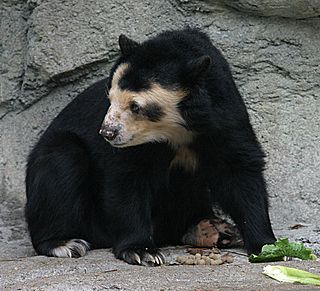 W
WThe spectacled bear, also known as the Andean bear, Andean short-faced bear, or mountain bear and locally as jukumari, ukumari (Quechua) or ukuku, is the last remaining short-faced bear. Its closest relatives are the extinct Florida spectacled bear, and the giant short-faced bears of the Middle to Late Pleistocene age. Spectacled bears are the only surviving species of bear native to South America, and the only surviving member of the subfamily Tremarctinae. The species is classified as Vulnerable by the IUCN because of habitat loss.
 W
WThe Atlantic titi or masked titi is a species of titi, a type of New World monkey, endemic to Brazil.
 W
WThe yellow-footed tortoise, also known as the Brazilian giant tortoise, commonly referred to as the Brazilian giant turtle, or more commonly, the big turtle, is a species of tortoise in the family Testudinidae and is closely related to the red-footed tortoise. It is found in the Amazon Basin of South America.
 W
WThe yellow-spotted Amazon river turtle or yellow-spotted river turtle is one of the largest South American river turtles. It can grow up to 45 cm long and weigh up to 8 kg. This species can be recognized by its black or brown oval carapace with distinctive low keels on the second and third scutes. Yellow spots on the side of its head give this species its common name. These spots are most prominent in juveniles and fade with age. Females can be up to twice the size of males.